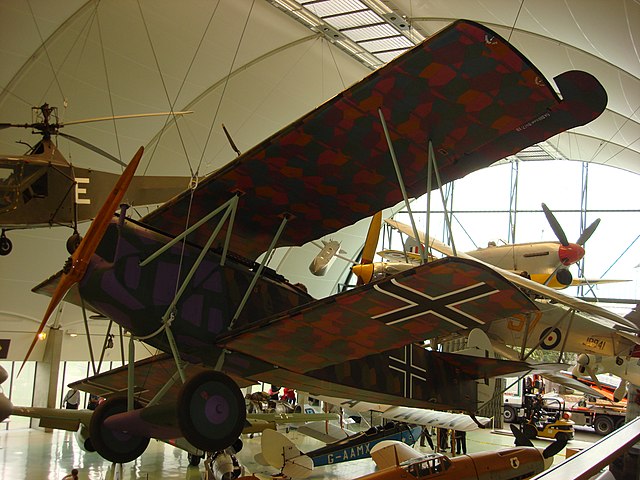Lozenge camouflage was a military camouflage scheme in the form of patterned cloth or painted designs used by some aircraft of the Central Powers in the last two years of World War I, primarily those of the Imperial German Luftstreitkräfte. It takes its name from the repeated polygon shapes incorporated in the designs, many of which resembled lozenges. In Germany it was called Buntfarbenaufdruck but this designation includes other camouflage designs such as Splittermuster and Leibermuster, and does not include hand-painted camouflage.
A Fokker D.VII shows a four-color Lozenge-Tarnung (lozenge camouflage), and its early Balkenkreuz black "core cross" on the fuselage has a white outline completely surrounding it.
Another Fokker D.VII with a typical five-color pattern
A five-color lozenge camouflage alternates with the pilot's personal color choice of pink on the fuselage of this Fokker D.VII reproduction. Its wing is covered in lozenge fabric.
Military camouflage is the use of camouflage by an armed force to protect personnel and equipment from observation by enemy forces. In practice, this means applying colour and materials to military equipment of all kinds, including vehicles, ships, aircraft, gun positions and battledress, either to conceal it from observation (crypsis), or to make it appear as something else (mimicry). The French slang word camouflage came into common English usage during World War I when the concept of visual deception developed into an essential part of modern military tactics. In that war, long-range artillery and observation from the air combined to expand the field of fire, and camouflage was widely used to decrease the danger of being targeted or enable surprise. As such, military camouflage is a form of military deception in addition to cultural functions such as political identification.
Sniper wearing a ghillie suit
A-7D Corsairs in a disruptive pattern, countershaded with white, on a disruptively painted surface, Thailand, 1972.
A Ferret armoured car with "Berlin camouflage" meant to hide it against that city's concrete buildings. Such terrain-specific patterns are rare.
Croatian army uniform (right) had by 2008 diverged from the former Yugoslavian army pattern, apparently for cultural reasons such as political identification.







